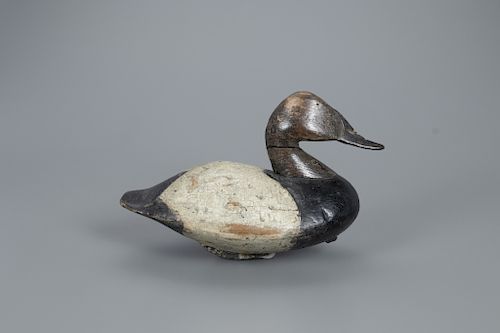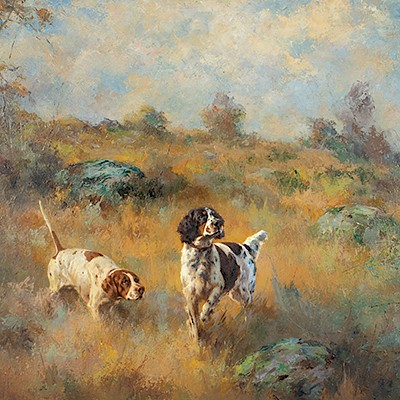Canvasback Drake Decoy, Lee Dudley (1860-1942)
About Seller
20 Winter Street
Pembroke, MA 02359
United States
Founded in 2005, Copley Fine Art Auctions is a boutique auction house specializing in antique decoys and American, sporting, and wildlife paintings. Over the course of the last two decades, the firm has set auction records for not only individual decoy makers, but also entire carving regions. Copley...Read more
Two ways to bid:
- Leave a max absentee bid and the platform will bid on your behalf up to your maximum bid during the live auction.
- Bid live during the auction and your bids will be submitted real-time to the auctioneer.
Bid Increments
| Price | Bid Increment |
|---|---|
| $0 | $50 |
| $1,000 | $100 |
| $2,500 | $250 |
| $5,000 | $500 |
| $10,000 | $1,000 |
| $25,000 | $2,500 |
| $50,000 | $5,000 |
About Auction
Feb 15, 2020
Charleston Marriott, 170 Lockwood Blvd., Charleston, SC 29403 Copley Fine Art Auctions cinnie@copleyart.com
- Lot Description
Canvasback Drake
Lee Dudley (1860-1942)
Knotts Island, NC, c. 1890
12 1/2 in. long
Dudley decoys have been held in the highest regard by acquisitors of all regions from the earliest days of decoy collecting. In fact, two of the seminal books on decoy collecting, William J. Mackey’s "American Bird Decoys" and Joel Barber’s "Water Fowl Decoys," both begin their first chapters with stories of Dudley decoys and the authors’ reverence for them. Barber's particular love of Dudley decoys is further illustrated in the first three plates of his book, the first of which depicts two Dudley carvings prominently displayed top and center on a wall of his decoys. In 1981 a panel of experts reviewing the decoy collection at the Shelburne Museum declared a Dudley of Barber’s to be the best of the museum’s collection. This lot is one of the finest examples of a Dudley ever to come to light and was made for Dudley’s personal gunning rig. The canvasback decoys from this rig represent some of the earliest Dudley carvings. They can be distinguished by their smooth humpbacks, painted eyes, and stylishly carved high-crowned heads. This decoy, along with other birds from this famous rig, bears Dudley’s original “LD” brand on the bottom. According to Barber, Lee Dudley recounted to him that “…in 1913 the whole Dudley rig had been sold to a [Knotts Island] club at the then prevailing price of fifty cents apiece.” This transfer of ownership is evident in the partial obscuring of Dudley’s rig brand on the underside.
The Dudley decoy has always been known for its bold, singular form. This carving retains the desirable attributes that astute Dudley collectors look for, including an original head, bill, and tail.
“A visual study of the complete Dudley bird form,” write Gene and Linda Kangas, “whatever the species, reveals an uninterrupted flow from bill tip to tail’s end. The successful manner in which the bill fits into the lower cheeks, the cut of the neck-base, sweeping powerful chest, and smooth, curved body combine into one of the finer sculptural solutions in the decoy world...The Dudley carving style consistently depicts both the head and body forms as a totality, resulting in a fine sculptural portrait.”
Muller acquired this decoy, along with a Cobb swimming goose, from Tony Waring at the time of the Mackey auctions, circa 1973. Several years later, this exact decoy was selected to be the logo bird for the Mid-Atlantic Waterfowl Festival. Subsequently, that logo has been used by the Atlantic Wildfowl Heritage Museum in Virginia Beach.
The form, provenance, rarity, and condition of this Knotts Island canvasback elevate it to a museum-quality level, positioning it as one of the best Southern decoys to ever be offered at auction.
In excellent condition by Dudley standards, old gunning paint with heavy wear, including a crack in the neck.
Provenance: Lee Dudley Rig
A Knotts Island gunning club rig, acquired from the above, 1913
Tony Waring Collection
Dr. Peter J. Muller Jr. Collection, acquired from the above, circa 1973
Literature: Kroghie Andresen, "Gunnin' Birds," Charlotte, NC, 2008, p. 82, exact decoy illustrated.
Henry A. Fleckenstein Jr., "Southern Decoys of Virginia and The Carolinas," Exton, PA, 1983, p. 50, color pl. XLVI, exact decoy illustrated.
Joe Engers, “Dr. Peter J. Muller: Bringing a good eye and an artistic approach to decoy collecting,” Decoy Magazine, January/February 2008, p. 9, exact decoy illustrated.
William J. Mackey Jr., "American Bird Decoys," New York, NY, 1965, p. 169, rigmate illustrated.
Joel Barber, "Wild Fowl Decoys," New York, NY, 1954, pp. 1-5, pl. 1-3, related example illustrated.
Gene and Linda Kangas, “Decoys: A North American Survey,” Spanish Fork, UT, 1983, pp. 3-4, color pl. 1, related decoy illustrated.
Quintina Colio, "American Decoys," Ephrata, PA, 1972, p. 1, related decoy illustrated.Please email condition report requests to colin@copleyart.com. Any condition statement given is a courtesy to customers, Copley will not be held responsible for any errors or omissions. The absence of a condition statement does not imply that the lot is in perfect condition.Condition
- Shipping Info
-
Copley Fine Art Auctions does not handle the shipping of any items. Shipping is the sole responsibility of the buyer. Once your payment has cleared and we have received your authorized shipping release form items may be released for shipment. Copley Fine Art Auctions, LLC shall have no liability for any loss or damage to such items. Buyers should allow up to four weeks for shipment. Please email info@copleyart.com for a shipping form. Please be aware that internet bidders may NOT not pick up their items at the sale. Items will be available for pick up by appointment or by shippers five days after the sale.
-
- Buyer's Premium



 EUR
EUR CAD
CAD AUD
AUD GBP
GBP MXN
MXN HKD
HKD CNY
CNY MYR
MYR SEK
SEK SGD
SGD CHF
CHF THB
THB















